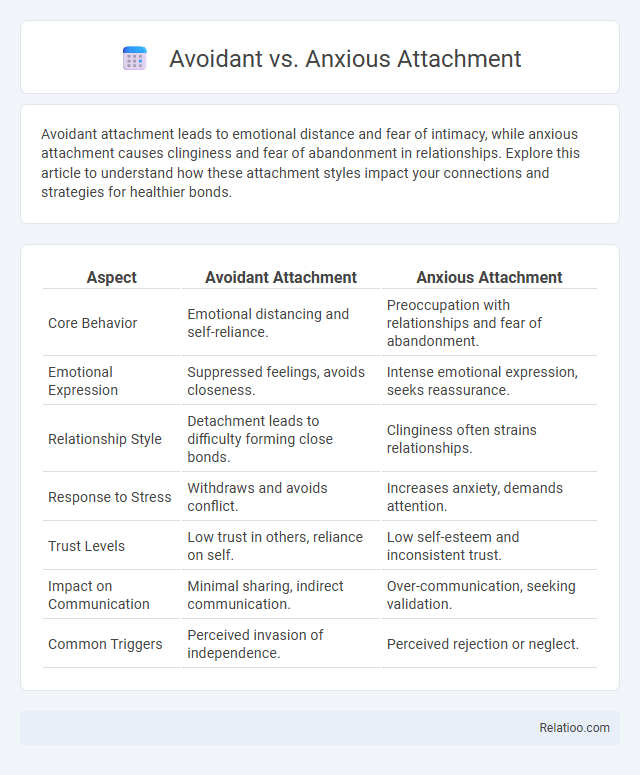Avoidant attachment leads to emotional distance and fear of intimacy, while anxious attachment causes clinginess and fear of abandonment in relationships. Explore this article to understand how these attachment styles impact your connections and strategies for healthier bonds.
Table of Comparison
| Aspect | Avoidant Attachment | Anxious Attachment |
|---|---|---|
| Core Behavior | Emotional distancing and self-reliance. | Preoccupation with relationships and fear of abandonment. |
| Emotional Expression | Suppressed feelings, avoids closeness. | Intense emotional expression, seeks reassurance. |
| Relationship Style | Detachment leads to difficulty forming close bonds. | Clinginess often strains relationships. |
| Response to Stress | Withdraws and avoids conflict. | Increases anxiety, demands attention. |
| Trust Levels | Low trust in others, reliance on self. | Low self-esteem and inconsistent trust. |
| Impact on Communication | Minimal sharing, indirect communication. | Over-communication, seeking validation. |
| Common Triggers | Perceived invasion of independence. | Perceived rejection or neglect. |
Understanding Attachment Theory
Understanding attachment theory reveals how avoidant attachment involves distancing from emotional closeness to protect yourself from rejection, while anxious attachment triggers intense fears of abandonment and craving for reassurance. Deactivation strategies often emerge in avoidant attachment, where your mind suppresses or minimizes emotional needs to maintain control and avoid vulnerability. Recognizing these patterns helps improve relationships by fostering awareness of your attachment style and promoting healthier emotional connections.
Defining Avoidant Attachment
Avoidant attachment is characterized by a strong emphasis on independence and emotional self-sufficiency, leading individuals to minimize closeness and suppress feelings to avoid vulnerability. This attachment style often results from early experiences where caregivers were unresponsive or dismissive, causing you to deactivate emotional needs as a defense mechanism. Understanding avoidant attachment helps differentiate it from anxious attachment, which involves heightened emotional dependency, and deactivation, a specific coping strategy within avoidant patterns.
Key Traits of Anxious Attachment
Anxious attachment is characterized by intense fear of abandonment, excessive need for reassurance, and heightened sensitivity to rejection cues. Individuals with anxious attachment often display clinginess, emotional volatility, and hypervigilance toward relationship dynamics. This attachment style contrasts with avoidant attachment, which involves emotional distancing and deactivation strategies that suppress attachment needs.
Emotional Responses in Relationships
Avoidant attachment is characterized by emotional distancing and suppression of feelings to maintain independence, often leading to deactivation of attachment needs. Anxious attachment triggers heightened emotional sensitivity and fear of abandonment, resulting in hyperactivation of attachment behaviors. These contrasting emotional responses shape how individuals regulate intimacy and cope with relational stress.
Communication Patterns: Avoidant vs Anxious
Avoidant attachment is characterized by emotional distance and reluctance to engage in deep conversations, often leading to minimal sharing and a tendency to downplay feelings. Anxious attachment drives a desire for constant reassurance and intense communication, which can manifest as frequent checking in and heightened sensitivity to perceived rejection. Your ability to recognize these differing communication patterns can improve relationship dynamics by fostering empathy and more effective interpersonal exchanges.
Triggers and Coping Mechanisms
Avoidant attachment is often triggered by perceived emotional closeness or demands, leading to coping mechanisms such as emotional withdrawal and suppression of feelings. Anxious attachment arises from fears of abandonment or inconsistency, resulting in heightened vigilance, seeking reassurance, and hyperactivation of emotional responses. Deactivation strategies involve shutting down attachment needs altogether, typically as a response to relational pain or rejection, and manifest through emotional distancing and minimizing the importance of relationships.
Impact on Romantic Relationships
Avoidant attachment is characterized by emotional distance and discomfort with intimacy, leading individuals to suppress needs and avoid closeness, which often results in partners feeling rejected or unvalued. Anxious attachment involves heightened sensitivity to relationship dynamics and a persistent fear of abandonment, driving behaviors aimed at seeking reassurance but sometimes causing perceived clinginess or dependency. Deactivation strategies in avoidant individuals further intensify emotional withdrawal, hindering effective communication and trust-building, thereby amplifying relational conflicts and reducing long-term relationship satisfaction.
Common Challenges and Conflicts
Avoidant attachment often leads to emotional withdrawal and difficulty in expressing needs, while anxious attachment causes heightened sensitivity to rejection and constant seeking of reassurance. Deactivation strategies involve suppressing emotions and distancing oneself to manage relational stress, which can result in misunderstandings and unmet emotional needs. Your relationships may face challenges such as communication breakdowns, trust issues, and cycles of pursuit and withdrawal, stemming from these conflicting attachment patterns.
Healing and Secure Attachment Strategies
Avoidant and anxious attachment styles often stem from early relational wounds manifesting as deactivation and hyperactivation of the attachment system, respectively. Healing involves fostering secure attachment through consistent emotional availability, mindfulness practices, and developing self-soothing techniques to regulate emotional responses. Engaging in therapeutic approaches such as Emotionally Focused Therapy (EFT) or Attachment-Based Therapy can support the transformation toward secure attachment by addressing core fears and promoting trust in relationships.
When to Seek Professional Help
Seek professional help when avoidant attachment leads to persistent emotional withdrawal that impairs relationships or when anxious attachment causes intense fear of abandonment and chronic anxiety. Therapy is essential if attempts to self-manage attachment-related deactivation or hyperactivation strategies result in overwhelming distress or functional impairment. Early intervention with a mental health specialist can promote healthier attachment patterns and improve emotional regulation.

Infographic: Avoidant vs Anxious Attachment
 relatioo.com
relatioo.com